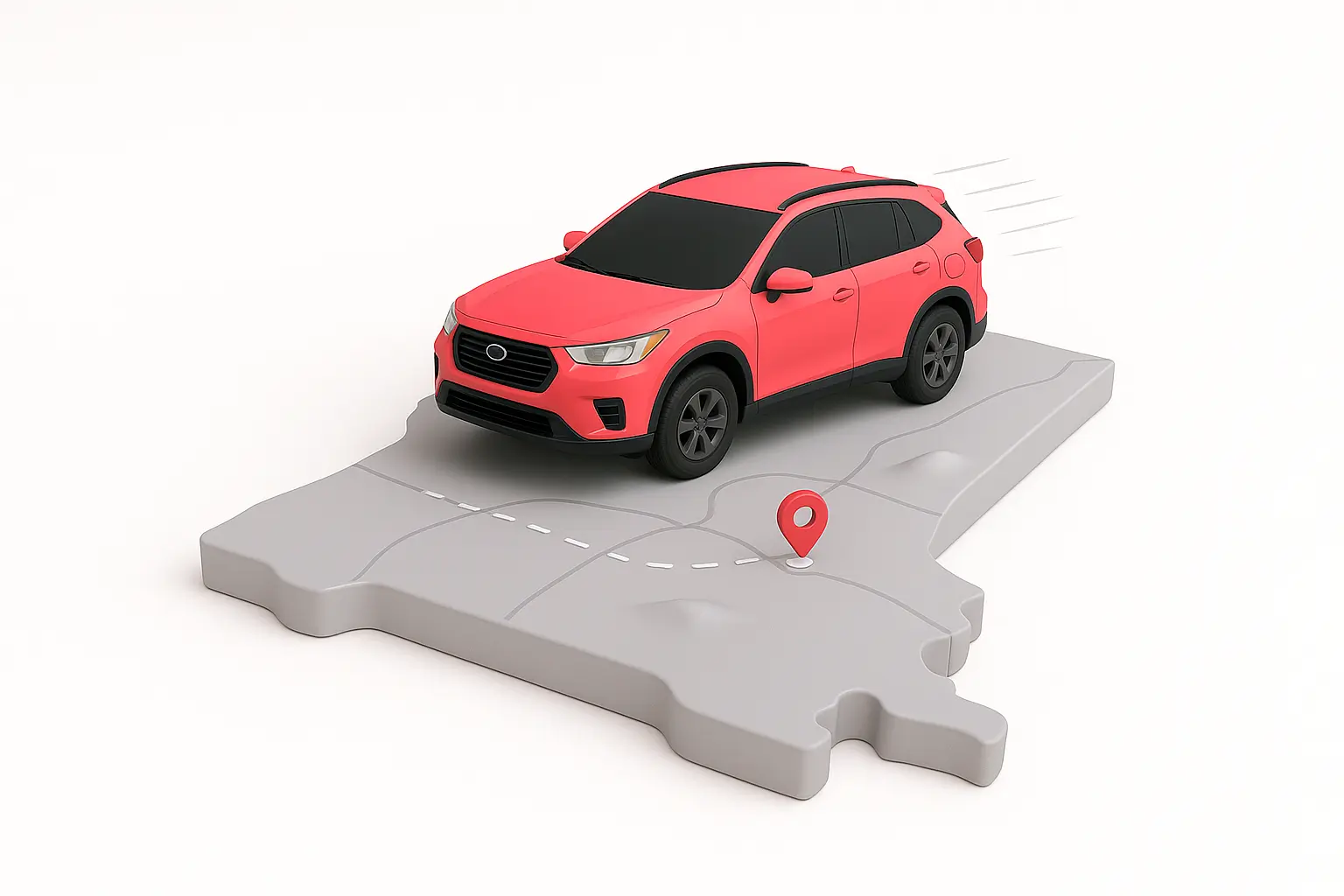A standard two-wheel (front-end) alignment runs from $70–$130, while full four-wheel alignments cost $120– $250. ”Lifetime” plans at big chains are often ~$200 and can pay off if re-adjusting more than once a year. Other potential costs include:
Pro tip: Ask the shop to center the wheel and keep thrust angle near zero. Also request a before/after printout.
Real customers Jerry has helped
Costs for getting your wheels aligned depend on your exact vehicle, where you live and the quality of oil used. With Jerry, you can quickly see what drivers are paying right now. Below are real examples of customers we’ve helped secure top prices for when they need their wheels aligned.
Estimates are modeled based on real vehicle and location data; names have been changed. Actual prices will vary by shop, parts, and vehicle condition.
Cost breakdown: Why the price varies
Alignment type and time:
A two-wheel alignment is quicker and cheaper; add $40-$120 to step up to a four-wheel alignment.
Vehicle design:
SUVs, trucks, luxury or performance models often need more setup time or special specs (+$20-$80). Some German and high-performance cars also require weight ballast or specific procedures.
Adjustability and hardware:
If your car lacks factory camber/caster adjustment, the shop may install cam bolts, offset bushings or a camber kit (+$60-$400 all-in). Many FWD torsion-beam rears need shim kits for toe/camber correction (+$80-$200 when required).
Condition of suspension/steering:
Worn tie rods, ball joints or control arm bushings prevent accurate adjustment; replacing them adds $150-$800+
ADAS and sensors:
Many vehicles need a steering angle sensor reset after alignment (+$25-$100).
Full ADAS camera/radar calibration only if mounts/components were disturbed or ride height changed runs $150-$500+.
Wheel/tire setup:
Oversized wheels, lowered or lifted suspensions or aftermarket arms increase labor time (+$30-$120).
Seized hardware/subframe shifts:
Rust-belt cars may need extra labor for stuck eccentrics, cam bolts or subframe nudges (ask for a call before add-ons).
Shop type and location:
Dealer labor rates and high-cost metro areas typically add $30-$100 to the car alignment price compared to independent shops in lower-cost regions.
Package pricing:
“Lifetime” or one–three year alignment plans cost from $150 to $250+. Check fine print (appointments, exclusions, fees). If a single alignment is ~$130, using a plan two or more times usually breaks even.
What is a wheel alignment?
A wheel alignment is a precision adjustment of your car’s suspension angles so the tires track straight and true. Jerry customers have learned that technicians set three primary angles:
- Toe: How much the tires point inward or outward when viewed from above (this is the biggest driver of tire wear).
- Camber: The inward or outward tilt of the tire when viewed from the front. Excess negative or positive camber chews tread on one edge.
- Caster: The forward or rearward tilt of the steering axis. It affects straight-line stability and steering return-to-center.
On a four-wheel alignment, the tech sets rear toe/camber first (building a straight “thrust line”), then sets front camber/caster to spec and centers the steering wheel.
What are the signs that I need a wheel alignment?
If you notice any of the following, an alignment check is a smart next step:
- Steering wheel off-center when driving straight.
- Car pulls or drifts left/right on a flat road.
- Uneven tire wear: inner/outer edge wear, feathering or rapid wear on one tire.
- Chirping/squealing tires in low-speed turns.
- Poor return-to-center after a turn or “darty” highway feel.
- After a curb or pothole hit, suspension work or tire replacement.
- ADAS or stability control acting oddly after steering/suspension repairs.
Vibration at specific speeds usually points to wheel balance or bent rims, not alignment — but misalignment can aggravate the feel and wear. A pull that swaps sides after switching the front tires is usually tire-related, not alignment.
Your action plan: How to save money
Check tires first:
Correct pressures and inspect for sidewall bubbles, bent rims or cupped/feathered tread. If the car pulls, swap front tires left/right; if the pull changes sides, it’s a tire (radial pull), not alignment.
Fix play before align:
Any looseness in tie rods, ball joints or wheel bearings must be addressed first. Ask the shop to show you the play on the rack.
Ask for before/after printouts:
Printouts prove the job and aid future diagnosis.
Bundle wisely:
If you’re buying tires, align the same day. Many shops discount alignment with tire purchases.
Avoid repeated charges:
If you’re replacing struts, control arms or tie rods soon, do the alignment after the parts are installed.
Drive straight, then decide:
On a flat road, confirm a centered wheel and no drift within one lane over five-10 seconds. If tires wear evenly and tracking is straight, you can wait— just recheck annually or after impacts.
Download the Jerry app to get accurate quotes from shops near you in minutes — you can compare alignment prices and packages by searching for an “alignment shop near me” with zero hassle.
Related repairs
Alignment is often paired with:
- Tie rod ends (inner/outer)
- Ball joints and control arms/bushings
- Struts and shocks
- Wheel bearings and hub assemblies
- Bent wheels or severely worn tires
- Rear axle/toe-camber shim kits (torsion-beam cars)
- Seized cam bolts/eccentrics (rust-belt replacements)
- Steering angle sensor resets and, where applicable, ADAS recalibration
Replacing worn parts first ensures the alignment holds and prevents you from paying twice.
DIY vs. Pro: Can I do this myself?
String-and-tape methods can get you close, but modern cars expect tight tolerances and a proper rack measures all four corners under load. If you track your car or wrench often, you can fine-tune toe at home — but for daily drivers, pro equipment pays for itself in tire life and safety.
Three months later, the vehicle was back and now had inner edge wear on the rotated tire as well as the one that was on the rear last time— so two of the new tires were now damaged.

What our customers are asking us
-
How often should I get an alignment?
-
How long does an alignment take?
-
Do I need an alignment with new tires?
-
Will an alignment fix steering wheel vibration?
-
Is a four-wheel alignment necessary?
-
Are “lifetime” alignment packages worth it?
-
Can I align right after replacing parts?

Jerel Lawrence is an experienced and certified automotive technician with a strong foundation in diagnostics, repair and technical mentorship. A graduate of NASCAR Technical Institute in 2010, Jerel began his career at national automotive repair chain locations, where he earned eight certifications from the National Institute for Automotive Service Excellence (ASE).
From 2017 to 2022, he worked as a General Motors-certified technician at a Cadillac dealership, refining his skills in manufacturer-specific diagnostics and service procedures. Today, Jerel leads as the senior technician and mentor at a family-owned repair facility, where he helps guide the next generation of technicians while ensuring top-quality service.
In addition to hands-on work, Jerel contributes to the automotive community through writing detailed articles and answering technical questions to help vehicle owners better understand and care for their cars.

Everett Cook is an award-winning journalist and editor with more than 10 years of experience across a variety of industries. In editing for Jerry, Everett’s mission is to help readers have a better understanding of the costs of owning or leasing a car and to better understand their vehicle in terms of insurance and repairs. Prior to joining Jerry, Everett was an editor for Axios. His previous work has been featured in The New York Times, The Los Angeles Times, The San Francisco Chronicle, The Atlantic, Atlantic Re:think, The Boston Globe, USA Today, and others. He’s also been a freelance writer and editor with experience in SEO, audience building, and long-term content roadmaps. Everett is a proud graduate of the University of Michigan.









